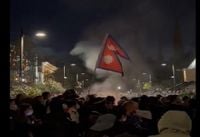South Asia is no stranger to political turmoil, but the past year has seen a wave of youth-led uprisings that have shaken governments and inspired movements far beyond the region’s borders. At the heart of this so-called “Asian Spring” is Nepal’s Gen Z movement—a digitally savvy, leaderless campaign that toppled a government and sparked fresh debate about the nature of protest, democracy, and foreign influence in the age of the internet.
It all began in early September 2025, when Nepal’s government, led by Prime Minister Oli, took a dramatic step: banning 26 foreign-owned social media sites after Facebook, Instagram, WhatsApp, YouTube, and LinkedIn refused to register with the Ministry of Communication and Information Technology. According to the Nepali Times, the move was part of a new National Cyber Security Policy modeled after China’s “Great Firewall,” aiming to curb foreign internet traffic and cultivate local platforms. While TikTok and Viber complied with the registration demand, the rest did not, prompting the government to act.
The ban was a spark in a powder keg. On September 4, the Federation of Nepali Journalists—backed by 22 civil society groups, many with funding from Western organizations like the National Endowment for Democracy (NED) and Open Society Foundations—issued a joint statement condemning the shutdown. Within days, thousands of young Nepalese, mobilized through Discord and TikTok, took to the streets, demanding an end to corruption and the restoration of digital freedoms. Their grievances were real: endemic graft, unemployment, and a political class seen as out of touch with the country’s youth.
What set the Gen Z uprising apart was its decentralized, almost chaotic organization. Instead of charismatic leaders, the movement coordinated through digital channels. The NGO Hami Nepal, previously known for earthquake relief, emerged as a central player, using its Instagram and Discord platforms to circulate protest information and guidelines. As Nepali Times reported, “Hami Nepal played a central role in guiding the demonstrations, using its Instagram and Discord platforms to circulate protest information and share guidelines.”
By September 8, the protests had escalated dramatically, with Hami Nepal even launching a “protest support helpline.” The demonstrations soon spiraled into violence, with some self-styled Gen Z leaders alleging that peaceful protests were “hijacked by opportunists.” Inside Hami Nepal’s Discord server, which boasted 145,000 members, users openly discussed extreme measures—including calls for violence and arson—raising troubling questions about the movement’s direction.
Despite the chaos, the Gen Z uprising achieved what few thought possible: the resignation of Prime Minister Oli and the installation of Nepal’s first female Prime Minister, Sushila Karki. The transition was as unconventional as the protests themselves, with Hami Nepal presiding over Karki’s “election” via Discord on September 12. No one knows exactly how many participated in the vote, but the symbolism was clear—Nepal’s youth had seized the reins of power, at least for the moment.
The impact of Nepal’s Gen Z movement has rippled far beyond the country’s borders. On October 3, thousands of youths in Tbilisi, Georgia, surrounded the presidential palace demanding sweeping political reforms. According to Georgia-based OC Media, a Nepali flag was spotted fluttering among the demonstrators, a potent symbol of inspiration drawn from Nepal’s recent youth-led uprising. One protester reportedly said the Georgian government had “put itself into the Nepalese scenario”—a direct reference to the Gen Z movement that led to regime change in Kathmandu.
Georgian protesters issued a five-point demand: fresh elections, the release of detained opposition leaders, an end to the suppression of journalists and activists, and Georgia’s accession to the European Union. The presence of the Nepali flag at the rally sparked diplomatic curiosity and debate, with commentators describing it as evidence that youth-led political awakenings are now transcending borders. The incident in Georgia adds to a growing list of movements inspired by Nepal’s Gen Z protest, including youth activists in Ladakh, India, and student demonstrators in France who have referenced Nepal’s uprising in their calls for “authentic democracy.”
Yet, for all its grassroots energy, questions swirl about the authenticity and autonomy of these movements. According to a detailed analysis published on October 5, 2025, in an article titled "How Nepal’s Gen Z Uprising Made the Case for a Decentralized Internet," there is mounting evidence of foreign funding and influence. The NED’s public grant listings include a $123,000 line item for “Promoting Youth Participation in the Struggle for Democracy,” earmarked for regional youth mobilization through workshops and advocacy. While not Nepal-specific, the timing coincides with Hami Nepal’s dramatic pivot from earthquake relief to political agitation.
Hami Nepal’s list of supporters reads like a who’s who of Western brands and organizations: luxury hotels, global clothing labels, messaging app Viber, Coca-Cola, and the Gurkha Welfare Trust—funded by the British Foreign Office and Ministry of Defence. Notably, Students for a Free Tibet, openly funded by the NED (widely recognized as a CIA front), is also among its backers. As the article notes, “the sudden transformation of Hami Nepal into a political vanguard fits squarely within that rubric.”
The US embassy in Nepal reportedly encouraged peaceful protest, with officials such as Ambassador Alaina B. Teplitz offering subtle support. Meanwhile, Western NGOs and media outlets amplified the movement’s message, fueling suspicions in Kathmandu and beyond that the Gen Z uprising was not entirely homegrown. This pattern echoes similar accusations in Bangladesh, Sri Lanka, and Indonesia, where governments have blamed foreign-funded NGOs and Western “democracy promotion” efforts for fomenting unrest.
In Bangladesh, a student-led revolt in 2024 forced longtime ruler Sheikh Hasina from power, with investigations alleging a foreign-backed regime change plot involving US agencies and NGOs. In Sri Lanka, the 2022–24 Aragalaya protests ousted the Rajapaksa dynasty, with nationalist leaders claiming international conspiracy. Indonesian President Prabowo Subianto has warned of foreign-funded NGOs trying to divide the nation under the guise of democracy and human rights.
Still, it would be naive to dismiss these uprisings as mere puppetry. The grievances—corruption, unemployment, dynastic politics, and repression—are real and deeply felt. As the article observes, "the uprisings in Bangladesh, Nepal, Sri Lanka, and Indonesia cannot be reduced to puppetry. They are driven by authentic discontent with corruption, inequality, dynastic politics and state repression. However, neither can they be read as wholly indigenous."
The story of Nepal’s Gen Z uprising, then, is one of local fire stoked by global oxygen. It is a movement born of genuine anger and aspiration, but one that has been amplified, directed, and legitimized by networks whose interests are not always aligned with those of the protesters. As youth across Asia and beyond look to Nepal for inspiration, the world is left to ponder: are these revolutions truly leaderless, or are they just the latest chapter in the long history of foreign intervention in the name of democracy?
The resonance of Nepal’s Gen Z movement in far-off places like Georgia and France is a testament to the power of digital mobilization and the universal yearning for justice. But as the dust settles, the question remains: can a decentralized, digitally enabled uprising deliver lasting change, or will it be swept up in the currents of global power politics?

